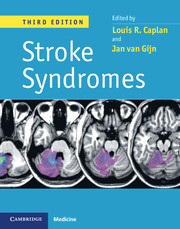Crossref Citations
This Book has been
cited by the following publications. This list is generated based on data provided by Crossref.
Hacking, Craig
and
Jones, Jeremy
2008.
Radiopaedia.org.
Kondziella, Daniel
and
Waldemar, Gunhild
2014.
Neurology at the Bedside.
p.
5.
Laganiere, Simon
Boes, Aaron D.
and
Fox, Michael D.
2016.
Network localization of hemichorea-hemiballismus.
Neurology,
Vol. 86,
Issue. 23,
p.
2187.
Malhotra, Konark
Goyal, Nitin
and
Tsivgoulis, Georgios
2017.
Internal Carotid Artery Occlusion: Pathophysiology, Diagnosis, and Management.
Current Atherosclerosis Reports,
Vol. 19,
Issue. 10,
Mahmoudi, Parisa
Veladi, Hadi
and
Pakdel, FiroozG
2017.
Optogenetics, Tools and Applications in Neurobiology.
Journal of Medical Signals & Sensors,
Vol. 7,
Issue. 2,
p.
71.
Zhang, Mingzhe
Liu, Raynald
Xing, Hongli
Luo, Huixuan
Cui, Leiting
and
Sun, Zhaosheng
2018.
A Simple and Rapid Puncture Method for Draining Hematoma in Pontine Hemorrhage.
Frontiers in Neurology,
Vol. 9,
Issue. ,
Grotta, James
Ramadan, Ahmad Riad
Denny, Mary Carter
and
Savitz, Sean I.
2019.
Acute Stroke Care.
2019.
Synopsis of Neurology, Psychiatry and Related Systemic Disorders.
p.
78.
Schowalter, Sean
Katz, Douglas I.
and
Lin, David J.
2021.
Clinical Reasoning: A 33-Year-Old Patient With Left-Sided Hemiparesis and Anarthria.
Neurology,
Vol. 96,
Issue. 3,
p.
128.
Cho, Hyunji
Kim, Taewon
Kim, Young-Do
Na, Seunghee
Choi, Yun Ho
Song, In-Uk
Chung, Sung-Woo
Koo, Jaseong
Kwon, Hyeryung
Park, Jeong Hyun
and
Im, Hansol
2022.
A clinical study of 288 patients with anterior cerebral artery infarction.
Journal of Neurology,
Vol. 269,
Issue. 6,
p.
2999.
Rim, Hyun Taek
Ahn, Jae Sung
Park, Jung Cheol
Byun, Joonho
Lee, Seungjoo
and
Park, Wonhyoung
2023.
The risk factors of postoperative infarction after surgical clipping of unruptured anterior communicating artery aneurysms: anatomical consideration and infarction territory.
Acta Neurochirurgica,
Vol. 165,
Issue. 2,
p.
501.





